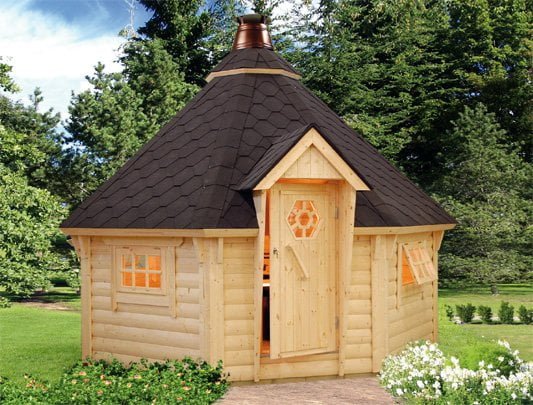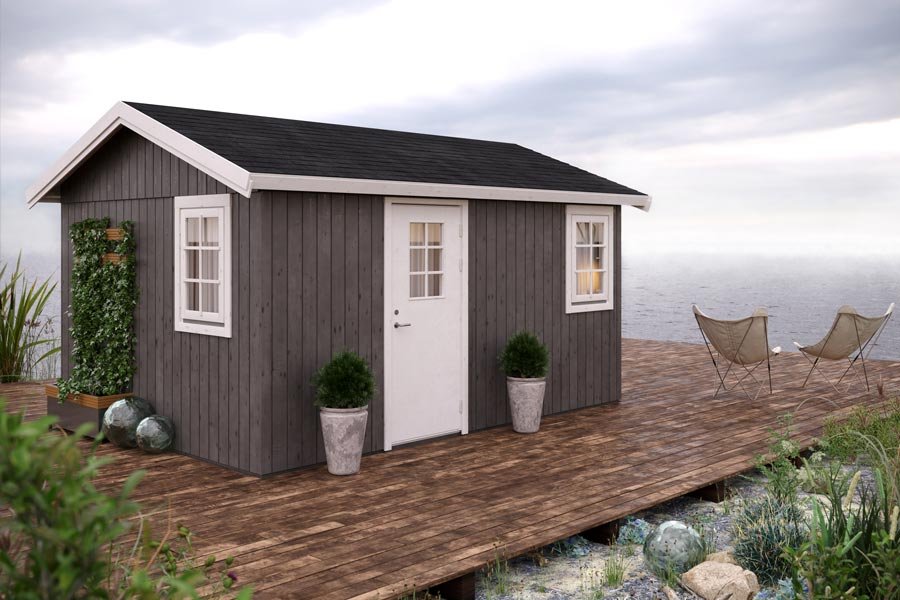How to heat a garden room – the best options and their pros and cons
With winter well and truly underway, ‘tis the season to be keeping your timber garden room snug and warm. Ideally, your shed or workroom will already be well insulated and draft proof – think dense timber walls, double-glazed windows, and quality flooring and roofing.
In addition, you can employ a variety of heating solutions to cope with any temperature the British weather can throw at you. So, to help stay warm and toasty this winter, here are 5 ways you can heat a garden office and transform it into a cold-proof refuge.
Using a wood-burning stove to heat a garden room

A very traditional form of heating, wood stoves offer both Nordic charm and excellent heating practicality, though they do need cleaning (emptying the ash pan and an occasional wipe of the glass in the door). All that’s required is some room to store logs, plus firelighters and kindling to provide ample heating for a medium-sized garden room.
Wood burners can cost from £500 to £2,000 and are available in rustic or more contemporary styles.
£100 should buy enough seasoned wood to last a stove the full winter, or you could make your waste paper into eco-friendly logs or briquettes using a log maker. These can cost less than £25 and are available from a number of online stores.
The downsides of wood burners include: the amount of space they take up; safety considerations (you’ll need a hearth and fireproof lining between the stove and timber walls); limited controllability in terms of heat output; and installation costs. If you do go for a stove, installation by a HETAS registered professional is advised.
When you consider the overall cost of the hardware and installation, a wood burning stove definitely isn’t the most cost effective way to heat a garden room. However, there’s nothing quite like sitting in a timber garden office in winter with a real fire flickering in the corner and the smell of wood smoke in the air.
Buying an electric stove to heat a garden office

If you want the look of a wood-burner without the need to store fuel and install a chimney, there is the option of an electric stove. These can be turned on and off instantly, need no cleaning, and there is no work involved in lighting them or maintaining the heat.
This is obviously labour-saving, but may not appeal if you like the ritual of lighting the stove or prefer the aesthetic of a ‘real’ wood-burner with ‘real’ wood. A browse on the Stovax website will give you a good idea of the range of designs and prices available.
Heating a garden room with an Oil-filled electric radiator

These are generally free-standing radiators which you plug into a socket to heat up the oil. They are very portable, require no installation, and are available in a wide range of sizes and styles. You can also buy wall-mounted models if you want a fixed source of heat, and it is also possible to buy models with thermostats and timers.
More versatile than a stove, they are also very cheap to buy, starting from about £25 and available at DIY stores. When it comes to heating a garden office you also save on the installation costs of a stove.
In terms of running costs, they will set you back around 20p an hour on a standard electricity meter – cheaper than a fan heater or radiant electric bar fire. After they have been switched off, oil filled electric radiators also retain their heat for some time (unlike fans or electric stoves, which lose their heat straight away).
Those are the pros; the downsides include: you may require more than one radiator if you want to heat a large garden room, especially since average heat output is lower than stoves and fan heaters. Additionally, they can take a while to warm up.
How to heat a garden room with an electric fan heater

Hugely portable, quick to buy and simple to operate, these are the easy choice for those who don’t want the hassle of having a stove installed, or just want occasional heat. You plug them in and you’re good to go, with instant heat. They can cost as little as £10 upfront.
However, this convenience comes at a price – they are more expensive to run than oil-filled radiators, setting you back nearly 30p an hour, which can build up over a full winter. Also, given their size, you may need several of these if you need to heat a large garden room or office. And though you can buy different sizes and designs, you’ll probably struggle to find one that will win you credibility points for style.
Heating a garden room with a portable gas heater

Again, these rarely make people’s wish lists of covetable design items, but traditionally they are a popular way to heat garden rooms and offices because you don’t need a power source. They’re portable, have no installation costs, have high heat output, and the heat is easily controlled.
All great attractions, but they are generally bulkier than electric heaters (because of the gas cylinder); and there are a couple of safety precautions. One is that you’ll need to ensure that the garden room is well ventilated when the fire is on (so that fumes and condensation doesn’t build up). Secondly you need to watch out for carbon monoxide leaks – buying a battery operated CO2 detector will solve this issue.
The most unusual way to heat a garden room

If you are planning to buy a garden room and are researching ways to heat it and want something truly novel, you could consider a Scandinavian style barbecue hut! GardenLife make and sell a small BBQ hut and a large hexagonal barbecue hut that can be purchased with an optional central grill and smoke extraction hood.

The design of these timber cooking huts was heavily influenced by traditional Swedish architecture and allows space for seating around a central stove. GardenLife sell the be barbecue grills, fixings and fittings with the huts. If you’re after a different look and a novel way to heat your garden room, this could be the option for you! You could entertain friends on even the coldest of winter days, stay warm around the fire, and even cook your dinner on the grill!
In summary; the pros and cons involved in heating a garden room or office
Wood burning stove
Pros: Choice of traditional styles, sustainable fuel, relatively low running costs, traditional atmosphere
Cons: Purchase and installation cost, space occupied can be large, limited heating controls, cleaning required, storage space for fuel required, ongoing maintenance costs, ventilation and CO2 detector required
Electric stove
Pros: Instant heat, thermostatic control, no maintenance costs, no fuel storage required
Cons: Medium to high running costs, requires mains electricity, limited traditional designs available, no heat retention when turned off
Oil-filled electric radiator
Pros: Low to medium running costs, wall mountable, thermostatic control, no cleaning, no maintenance costs, no fuel storage required, retains some heat when turned off
Cons: Lower and slower heat output than stoves, requires mains electricity, no traditional designs available, may require two or more units
Electric fan heaters
Pros: Highly portable,compact, cheapest to buy
Cons: High running costs, requires mains electricity, limited heat output compared to stoves, no traditional styles available, no heat retention when turned off, may require two or more units
Gas heaters
Pros: Low running costs, no mains supply needed, instant heat, heating control, no maintenance costs
Cons: Bulky design, limited traditional designs, ventilation and CO2 detector required
BBQ hut with grill
Pros: Beautiful traditional Scandinavian design, heating and cooking area combined, sustainable fuel, relatively low running costs
Cons: Purchase and installation cost, no heating controls, regular cleaning required, storage space for fuel required, ongoing maintenance costs, ventilation and CO2 detector required
All in all, there’s a great range of choice of solutions for surviving the bleak midwinter, although it’s fair to say that every solution has its downsides as well as its attractions. If you want a more detailed comparison of running costs, the Centre for Sustainable Energy has useful information.
Beyond buying, installation and costs, other criteria for your choice heating appliance for a garden room should include:
- how much space you have
- whether you want occasional or ongoing heating, and freestanding or permanent solutions
- safety issues, for example ventilation and whether you work with flammable materials such as sawdust (in which case you won’t want an exposed heating element)
Enjoy the winter!

















